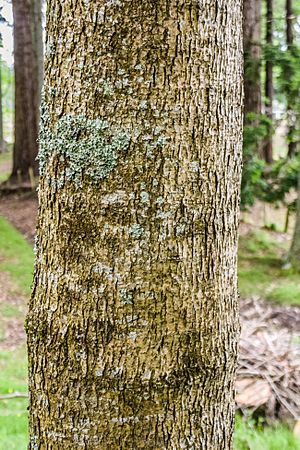Nogal criollo facts for kids
The nogal criollo (say: NOH-gahl KREE-oh-yo), also known as Juglans australis, is a type of plant in the Juglandaceae family. This family includes many kinds of walnut trees. This large tree grows quickly and can reach up to 20 meters (about 65 feet) tall! You can find it in the mountains of Argentina and Bolivia, especially in places called the Southern Andean Yungas. These are montane cloud forests on the eastern side of the Andes mountains. Sadly, this tree is threatened because its home is being lost.
Quick facts for kids Nogal criollo |
|
|---|---|
 |
|
| Bark of tree at Hackfalls Arboretum, New Zealand | |
| Conservation status | |
| Scientific classification | |
| Genus: |
Juglans
|
| Species: |
australis
|
Contents
What the Nogal Criollo Looks Like
The Juglans australis is a wide, spreading tree that loses its leaves every year (it's deciduous). It can grow up to 25 meters (about 82 feet) wide. Its trunk can be straight and grow up to 6 meters (about 20 feet) tall and 5 decimeters (about 20 inches) across.
Leaves and Wood
The leaves of the nogal criollo are special. They are called pinnately compound leaves. This means that each leaf is made up of many smaller leaflets arranged along a central stem. There can be up to fifteen of these small, oval-shaped leaflets on one leaf. The edges of these leaflets are finely toothed, like a tiny saw.
The wood from this tree is very good quality. It is strong, hard, and quite heavy.
Special Plant Powers
Like most walnut trees, the Juglans australis produces a natural chemical called juglone. This substance helps the tree by making it harder for other plants to grow too close. It's like the tree is saying, "Stay away from my space!"
This tree is also tougher against cold weather than the well-known Persian walnut (Juglans regia).
How People Use the Nogal Criollo
People use different parts of the nogal criollo tree.
Eating the Nuts and Fruits
When the fruits are still young and not fully grown, people sometimes pickle them whole. The nuts, once they are ripe, are also collected and eaten. They are a tasty snack!
Traditional Uses
The concentrated liquid from the husk (the outer covering) of the nut has been used in traditional ways. It was used to help get rid of internal parasites.
See also
 In Spanish: Juglans australis para niños
In Spanish: Juglans australis para niños


